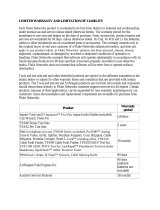
1730
Calibration Manual
4
Specifications
General Specifications
Color LCD Display ................................................ 4.3-inch active matrix TFT, 480 pixels x 272 pixels, resistive touch
panel.
Power/Charging/LED Indicator
Warranty
1730 and Power Supply ...................................... 2 years (battery not included)
Accessories ........................................................ 1 year
Calibration Cycle ................................................... 2 years
Dimensions
1730 .................................................................... 19.8 cm x 16.7 cm x 5.5 cm (7.8 in x 6.6 in x 2.2 in)
Power Supply ...................................................... 13.0 cm x 13.0 cm x 4.5 cm (5.1 in x 5.1 in x 1.8 in)
1730 with power supply attached ....................... 19.8 cm x 16.7 cm x 9 cm (7.8 in x 6.6 in x 3.5 in)
Weight
1730 .................................................................... 1.1 kg (2.5 lb)
Power Supply ...................................................... 400 g (0.9 lb)
External Protection ............................................... Holster, Kensington lock
Environmental Specifications
Operating Temperature ........................................ −10 °C to 50 °C (14 °F to 122 °F)
Storage Temperature ............................................ −20 °C to 60 °C (−4 °F to 140 °F), with battery: −20 °C to 50 °C (−4 °F
to 122 °F)
Operating Humidity ............................................... <10 °C (<50 °F) non condensing
10 °C to 30 °C (50 °F to 86 °F) ≤95 %
30 °C to 40 °C (86 °F to 104 °F) ≤75 %
40 °C to 50 °C (104 °F to 122 °F) ≤45 %
Operating Altitude ................................................. 2,000 m (up to 4,000 m derate to 1000 V CAT II/600 V CAT III/300 V
CAT IV)
Storage Altitude .................................................... 12,000 m
IP Rating ................................................................ IEC 60529:IP50, in connected condition with protection caps in place.
Vibration ................................................................ MIL 28800E, Type 3, Class III, Style B
Safety ..................................................................... IEC 61010-1: Overvoltage CAT IV, Measurement 1000 V CAT III / 600
V CAT IV, Pollution Degree 2
Electromagnetic Environment ............................. IEC 61326-1: Industrial
Electromagnetic Compatibility ............................ Applies to use in Korea only. Class A Equipment (Industrial
Broadcasting & Communication Equipment)
[1]
[1] This product meets requirements for industrial (Class A) electromagnetic
wave equipment and the seller or user should take notice of it. This
equipment is intended for use in business environments and not to be used
in homes.
Radio Frequency Emissions ................................ IEC CISPR 11: Group 1, Class A.
Group 1 has intentionally generated and/or use conductively coupled
radio-frequency energy which is necessary for the internal functioning
of the equipment itself.
Class A equipment is suitable for use in non-domestic locations and/or
directly connected to a low-voltage power supply network.
Electrical Specifications
Power Supply
Voltage Range .................................................... nominal 100 V to 500 V (85 V min to 550 V max) using safety plug
input
Mains Power ....................................................... nominal 100 V to 240 V (85 V min to 265 V max) using IEC 60320 C7
input (figure 8 power cord)
Power consumption ............................................ Maximum 50 VA (max. 15 VA when powered using IEC 60320 input)
Standby Power ................................................... <0.3 W only when powered using IEC 60320 input
Efficiency ............................................................ ≥68.2 % (in accordance with energy efficiency regulations)
Mains Frequency ................................................ 50/60 Hz ±15 %
Battery Power ..................................................... Li-ion 3.7 V, 9.25 Wh, customer-replaceable






















